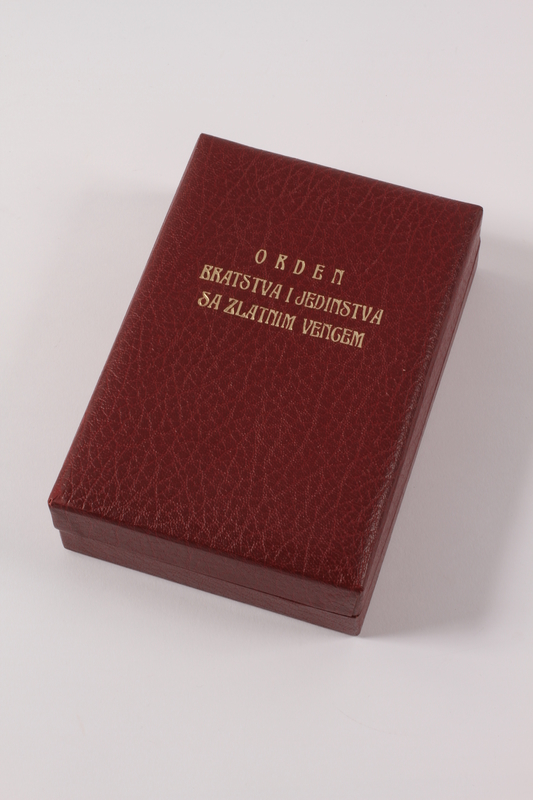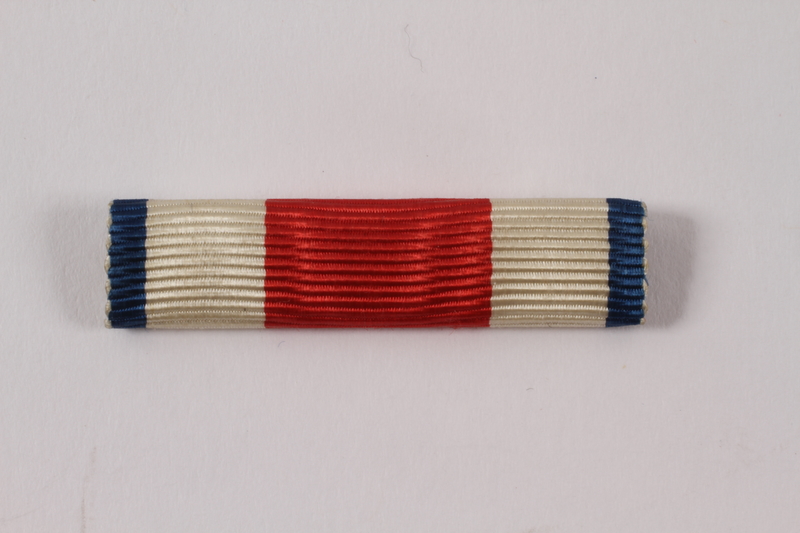Overview
- Brief Narrative
- Order of Brotherhood and Unity medal awarded to Jamila (Zamila) Kolonomos in 1950, in recognition of her service as a partisan during the Axis occupation of Yugoslavia from 1941-1945. The medal was awarded to both citizens and foreigners for creation and promotion of brotherhood and unity when resistance was divided by politics, nationality, and other factors. On April 6, 1941, the Axis powers, Germany, Italy, Hungary, and Bulgaria, invaded and partitioned Yugoslavia. The Macedonian region, including Bitola where Jamila and her family lived, was occupied by Bulgaria. Jamila worked with resistance groups to fight the occupation and was forced to hide at night for her safety. On March 9, 1943, from her hiding place, Jamila witnessed the roundup and deportation of the Jewish community of Bitola. After a month in hiding, she went to the mountains and joined a partisan detachment. In August 1943, Jamila’s group became part of the Macedonian Partisan Battalion, which liberated a prisoner camp in Greece. In June 1944, a separate Macedonian brigade was formed. In August, Jamila was injured during a battle. On October 30, Jamila’s group liberated the towns of Ohrid and Struga, and a month later Macedonia was liberated. In December, Jamila served as an official at the Second Congress of Anti-Fascist Youth in Skopje. Jamila married a fellow partisan Chede Filipovski. Germany surrendered on May 7, 1945. Jamila returned to Bitola and discovered that her entire family had been deported and murdered at Treblinka killing center. In June Chede was killed in a motorcycle accident. In June 1947, Jamila married Avram Sadikario.
- Date
-
commemoration:
1941-1945
received: 1950 April 14
- Geography
-
received:
Yugoslavia
- Credit Line
- United States Holocaust Memorial Museum Collection, Gift of Jamila Kolonomos
- Markings
- b. front, gold : Orden / Bratstva I Jedinstva / Sa Zlatnim Vengem [Order of Brotherhood and Unity with the Golden Belt]
- Contributor
-
Subject:
Jamila A. Kolonomos
- Biography
-
Jamila (Zamila) Kolonomos was born on June 18, 1922 in Bitola, Yugoslavia (now North Macedonia), to a Jewish couple, Isak and Esterina Fransez Kolonomos. Jamila had an older sister, Bela (b. 1920) and 3 younger siblings, Kalef (b. 1925), Menahem (b.1927) and Rachela (b.1930.) Isak was born in 1893 in Monastir (now Bitola), to Kalef and Djamila Kasorla Kolonomos. Isak’s family was Romaniote, Greek Jews that had lived in Ioannina (Yannina) Greece, since Roman times and moved to Monastir in the late 1800s. During the Ottoman period the town was called Monastir, when Macedonia was annexed by Serbia in 1913, it was renamed Bitola, the Jews however, continued calling it by its old name. Esterina was from Skopje, Macedonia where her father was a hakham at a synagogue. Isak served in the Bulgarian Army during World War I, where he met his future wife. In 1920 the Kolonomos family moved to Bitola where Isak worked at the Banque Franco-Serbe, later becoming director. Jamila’s family observed the Jewish holidays, but was not very religious and spoke Ladino, Greek, French, Serbian and Turkish. She was a member of Hashomer Hatzair, a Zionist youth organization that prepared Jewish youth for a life in Palestine. Esterina died of heart disease in March 1941.
On April 6, 1941, Germany and Italy invaded Yugoslavia, supported by Hungary and Bulgaria. Yugoslavia quickly capitulated and Bitola was occupied by Germany, then Bulgaria. Bulgarian authorities passed many anti-Semitic laws that restricted the everyday lives of the Jewish community. In October 1941 Jews were banned from engaging in industry or commerce, later in 1941 Jews were forced to live in the poor side of Bitola, establishing a ghetto. Jamila’s sister, Bela married Moise Kassorla on November 16, and the couple moved to Skopje. In July 1942 all Jewish households were ordered to hand over 20% of the value of their assets and in autumn 1942 Jews were denied citizenship and were forced to wear Star of David buttons. Jewish students were no longer allowed in school so Jamila’s brothers began to learn office work and she and her sister Rachela learned to sew and cared for their ill grandmother. A coworker denounced Isak to the authorities, who forced him to open the bank safe and confiscated the contents inside. Due to the anti-Jewish restrictions he was not able to find another job. As a Hashomer Hatzair member, Jamila supported anti-Fascist efforts, made shoes for partisans, and collected discarded weapons. Jamila joined other members in forming small underground resistance groups, creating 3 for youth and another for women.
On March 9, 1943 Jamila was warned by a resistance leader that because of her work with the resistance groups, it was unsafe for her to sleep at home. He gave her the address of Stojan-Bogoja Siljanovski’s cigarette kiosk near a police station where she could hide for the night. Before accepting the offer, she and her father discussed putting the family in hiding but her father decided against it, not wanting to leave his invalid mother. Jamila spent the night locked in the kiosk with Estela Levi. Early in the morning of March 11, while they remained hidden, the two began hearing shouting and crying as the soldiers marched the Jewish townspeople through the streets. The kiosk owner did not return until that evening, bringing 3 more Jewish women: Roza Ruso, Estreya Ovadya, and Adela Faradji. Jamila and Estela learned that the Jews were pulled from their homes by police and Bulgarian soldiers, taken to a rail station, had their valuables confiscated, were loaded on to cattle cars, and transported north to Skopje. Jamila and her companions hid in this cold, cramped space with little to no access to food, water or bathrooms. Every day they heard police buying cigarettes and talking on the other side of the curtain that kept them hidden.
On April 7, the women acquired safe passage to the mountains in Greece where they joined the partisan group Damyan Gruev. Jamila was given the alias Tsveta (Flower) and became one of the 10 Jews in the 30 person unit, fighting the occupying forces. Jamila was appointed Commissar, the political leader of the detachment and acted as the editor of their first newspaper. In August, Jamila’s group merged with two other detachments, Goce Delchev and Pitu Goli to form the first Macedonian Battalion, Mirche Acev bringing their number up to 130 members. The battalion liberated a group of Serbs and Slovenes from a prisoner camp in Greece, who joined them to form Brigade 1 (Tovimos). In September, Jamila was appointed Commissar, she became responsible for preparing status and logistical reports for the battalion, and organizing literacy lessons and presentations in liberated cities. The winter of 1943-44 was harsh, many men froze to death or starved. Jamila nearly succumbed as well but, she was saved by Chede Filipovski.
In June 1944, the Serbs and the Slovenes returned to their own regions and a separate Macedonian Brigade was established. Jamila acted as deputy Commissar for the newly formed brigade as well as for the 42nd Yugoslav Division. In August, Jamila was wounded in the back by an exploding shell during a battle to liberate Debar. On October 30, she helped liberate Ohrid and Struga. The Macedonia region was liberated in November. In December Jamila married Chede Filpovski.
Germany surrendered May 7, 1945, and after the war Jamila and Chede returned to Bitola. In June, Chede died in a motorcycle accident. In July, their daughter, Mira was born. Jamila stayed in Bitola hoping that her friends and family would return. Instead she learned that those who had been taken away joined Jews from Skopje and Shtip. They were all held in Monopol Tobacco Warehouse in Skopje, enduring continual inspections and beatings with inadequate food or water. They were held for 3 weeks before being deported in 3 shipments to Treblinka killing center in German occupied Poland. Those who reached Treblinka, including Jamila’s father, grandmother, sisters Bela and Rachela and brothers Menaham and Kalef were murdered upon arrival. Approximately 98 percent of the Macedonian Jewish community was murdered at Treblinka. At the end of the year Jamila moved to Skopje, where there was a larger Jewish community. In June 1947, she married Avram Sadikario, (1919-2007) a fellow survivor from Bitola. They had one son, Samuel.
Jamila was recognized many times for merit and bravery in her wartime service, receiving many national medals. She received a Doctorate in Landino and was named Professor Emeritus at Sts. Cyril and Methodus University. Jamila wrote numerous articles and books on the Yugoslav-Macedonian Resistance. She became a leading official in many political, benevolent, and social associations, including the Alliance of Yugoslav Resistance, the Union for Protection of Childhood of Macedonia, and the Alliance of Anti-Fascist Women of Macedonia. She served as deputy in the Macedonian Assembly. Jamila, age 91, died on June 18, 2013 in Skopje.
Physical Details
- Language
- Serbian
- Classification
-
Military Insignia
- Category
-
Medals
- Object Type
-
Medals, Yugoslav (lcsh)
- Physical Description
- a. Circular gold colored metal medal with a red and gold circular center surrounded by an outer ring. The center depicts the emblem of Yugoslavia in relief; 6 red enamel flaming torches joining their flames under a red, 5 pointed star on a gold colored, stippled background. A raised red band with 5 pointed, golden stars and a gold edge surrounds the image. The outer gold laurel wreath ring is attached with 5, grooved spokes. The back has a horizontal 2 prong pin with a rollover c-clasp, 2 rivets and a maker’s mark on the bottom right.
b. Rectangular, hinged, cardboard, clamshell box covered with dark red treated paper. The interior lid is padded and covered with white fabric with the lid and base connected with cloth. The base is lined with white cardboard and has a cardboard insert covered in black plush cloth with a depression for the medal and bar pin. The bottom is covered with red cloth.
c. Gold colored metal bar pin with crimped sides covered by a grosgrain ribbon with 5 vertical stripes: narrow blue, white, wide red, white, narrow blue. A safety clasp pin is attached to the back between the sides of the bar. - Dimensions
- a: Depth: 0.500 inches (1.27 cm)
b: Height: 7.125 inches (18.098 cm) | Width: 4.750 inches (12.065 cm) | Depth: 1.875 inches (4.763 cm)
d: Height: 0.375 inches (0.953 cm) | Width: 1.500 inches (3.81 cm) | Depth: 0.125 inches (0.318 cm) - Materials
- a : metal, enamel, paint
b : cardboard, cloth, ink
c : metal, ribbon
Rights & Restrictions
- Conditions on Access
- No restrictions on access
- Conditions on Use
- No restrictions on use
Keywords & Subjects
Administrative Notes
- Legal Status
- Permanent Collection
- Provenance
- The medal was donated to the United States Holocaust Memorial Museum in 2011 by Jamila Kolonomos.
- Funding Note
- The cataloging of this artifact has been supported by a grant from the Conference on Jewish Material Claims Against Germany.
- Record last modified:
- 2022-07-28 21:51:30
- This page:
- https://collections.ushmm.org/search/catalog/irn43777
Also in Jamila Kolonomos collection
The collection consists of medals, medallions, bar pins, cases, certificates, an oral history, documents, photographs and CDs with songs in Ladino relating to the experiences of Jamila Kolonomos and her family in Bitola, Yugoslavia before and during the Holocaust, her time as a partisan fighter, and of Jamila and her husband in Skopje, Yugoslavia. Some of these materials may be combined into a single collection in the future.
Date: 1941-2005
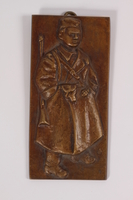
Kurir Jovica plaque, box, and card awarded to a Macedonian Jewish partisan woman
Object
Kurir Jovica plaque set awarded to Jamila (Zamila) Kolonomos on December 16, 1972, by the Council for the Education and Protection of Children of Yugoslavia, to recognize her work with children. The design was inspired by the Kurir Jovica statue, an award for achievement presented by the Yugoslav Union of Pioneers, a society created to indoctrinate children with communist ideology. On April 6, 1941, the Axis powers Germany, Italy, Hungary, and Bulgaria, invaded and partitioned Yugoslavia. The Macedonian region including Bitola where Jamila and her family lived was occupied by Bulgaria. Jamila worked with resistance groups to fight the occupation and was forced to hide at night for her safety. On March 9, 1943, from her hiding place, Jamila witnessed the roundup and deportation of the Jewish community of Bitola. After a month in hiding she went to the mountains and joined a partisan detachment. In August 1943, Jamila’s group became a part of the Macedonian Partisan Battalion, which liberated a prisoner camp in Greece. In June 1944, a separate Macedonian brigade was formed. In August, Jamila was injured during a battle. On October 30, Jamila’s group liberated the towns of Ohrid and Struga and a month later Macedonia was liberated. In December, Jamila served as an official at the Second Congress of Anti-Fascist Youth in Skopje. Around this time Jamila married a fellow partisan Chede Filipovski. Germany surrendered on May 7, 1945. Jamila returned to Bitola and discovered that her entire family had been deported and murdered at Treblinka killing center. In June Chede was killed in a motorcycle accident. In June 1947, Jamila married Avram Sadikario.
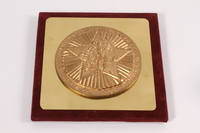
Medallion, box and certificate awarded to Macedonian Jewish partisan woman
Object
Gold medallion set awarded to Jamila (Zamila) Kolonomos on October 11, 2005, for her efforts as a partisan fighter during the Axis occupation of Yugoslavia from 1941 to 1945. On April 6, 1941, the Axis powers Germany, Italy, Hungary, and Bulgaria, invaded and partitioned Yugoslavia. The Macedonian region, including Bitola where Jamila and her family lived, was occupied by Bulgaria. Jamila worked with resistance groups to fight the occupation and was forced to hide at night for her safety. On March 9, 1943, from her hiding place, Jamila witnessed the roundup and deportation of the Jewish community of Bitola. After a month in hiding, she went to the mountains and joined a partisan detachment. In August 1943, Jamila’s group became part of the Macedonian Partisan Battalion, which liberated a prisoner camp in Greece. In June 1944, a separate Macedonian brigade was formed. In August, Jamila was injured during a battle. On October 30, Jamila’s group liberated the towns of Ohrid and Struga, and a month later Macedonia was liberated. In December, Jamila served as an official at the Second Congress of Anti-Fascist Youth in Skopje. Jamila married a fellow partisan Chede Filipovski. Germany surrendered on May 7, 1945. Jamila returned to Bitola and discovered that her entire family had been deported and murdered at Treblinka killing center. In June Chede was killed in a motorcycle accident. In June 1947, Jamila married Avram Sadikario
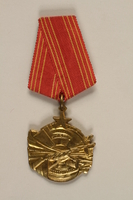
Yugoslav Orden za Hrabrost medal, ribbon, box, and certificate awarded to a Macedonian Jewish partisan woman
Object
Yugoslav Order of Bravery medal set awarded to Jamila (Zamila) Kolonomos on June 3, 1947 in recognition of her efforts as a partisan fighter during World War II. The medal was instituted August 15, 1943 and was awarded to both military personnel and civilians for acts of bravery during World War II. The motto of the Yugoslavian partisan movement, “Death to fascism, freedom to the people” is embossed on the face. On April 6, 1941, the Axis powers, Germany, Italy, Hungary, and Bulgaria, invaded and partitioned Yugoslavia. The Macedonian region, including Bitola where Jamila and her family lived, was occupied by Bulgaria. Jamila worked with resistance groups to fight the occupation and was forced to hide at night for her safety. On March 9, 1943, from her hiding place, Jamila witnessed the roundup and deportation of the Jewish community of Bitola. After a month in hiding, she went to the mountains and joined a partisan detachment. In August 1943, Jamila’s group became part of the Macedonian Partisan Battalion, which liberated a prisoner camp in Greece. In June 1944, a separate Macedonian brigade was formed. In August, Jamila was injured during a battle. On October 30, Jamila’s group liberated the towns of Ohrid and Struga, and a month later Macedonia was liberated. In December, Jamila served as an official at the Second Congress of Anti-Fascist Youth in Skopje. Jamila married a fellow partisan Chede Filipovski. Germany surrendered on May 7, 1945. Jamila returned to Bitola and discovered that her entire family had been deported and murdered at Treblinka killing center. In June Chede was killed in a motorcycle accident. In June 1947, Jamila married Avram Sadikario
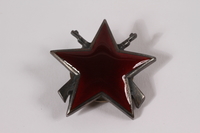
Yugoslavian Order of the Partisan Star awarded to a Macedonian Jewish partisan woman
Object
Yugoslavian Order of the Partisan Star, 3rd class, medal set awarded to Jamila (Zamila) Kolonomos on March 18, 1952, in recognition of her efforts as a partisan fighter during the Axis occupation of Yugoslavia from 1941-1945. This medal was awarded to military leaders for successfully commanding military units and for bravery displayed during WW II. On April 6, 1941, the Axis powers, Germany, Italy, Hungary, and Bulgaria, invaded and partitioned Yugoslavia. The Macedonian region, including Bitola where Jamila and her family lived, was occupied by Bulgaria. Jamila worked with resistance groups to fight the occupation and was forced to hide at night for her safety. On March 9, 1943, from her hiding place, Jamila witnessed the roundup and deportation of the Jewish community of Bitola. After a month in hiding, she went to the mountains and joined a partisan detachment. In August 1943, Jamila’s group became part of the Macedonian Partisan Battalion, which liberated a prisoner camp in Greece. In June 1944, a separate Macedonian brigade was formed. In August, Jamila was injured during a battle. On October 30, Jamila’s group liberated the towns of Ohrid and Struga, and a month later Macedonia was liberated. In December, Jamila served as an official at the Second Congress of Anti-Fascist Youth in Skopje. Jamila married a fellow partisan Chede Filipovski. Germany surrendered on May 7, 1945. Jamila returned to Bitola and discovered that her entire family had been deported and murdered at Treblinka killing center. In June Chede was killed in a motorcycle accident. In June 1947, Jamila married Avram Sadikario.

UNICEF medallion with box awarded to a Macedonian Jewish partisan woman
Object
United Nations International Children's Emergency Fund (UNICEF) medallion awarded to Jamila (Zamila) Kolonomos by the Yugoslav Commission for Cooperation with UNICEF. UNICEF was created to protect the rights and wellbeing of children in response to the chaos of Europe in the aftermath of World War II. Yugoslavia was the first country in Europe to establish a National Committee for UNICEF. In 1965 the Committee changed its name to the Yugoslav Commission for Cooperation with UNICEF. The medallion was awarded after the war to recognize Jamila’s work with the Yugoslav Department for Protection of Mothers and Children. On April 6, 1941, the Axis powers, Germany, Italy, Hungary, and Bulgaria, invaded and partitioned Yugoslavia. The Macedonian region, including Bitola where Jamila and her family lived, was occupied by Bulgaria. Jamila worked with resistance groups to fight the occupation and was forced to hide at night for her safety. On March 9, 1943, from her hiding place, Jamila witnessed the roundup and deportation of the Jewish community of Bitola. After a month in hiding, she went to the mountains and joined a partisan detachment. In August 1943, Jamila’s group became part of the Macedonian Partisan Battalion, which liberated a prisoner camp in Greece. In June 1944, a separate Macedonian brigade was formed. In August, Jamila was injured during a battle. On October 30, Jamila’s group liberated the towns of Ohrid and Struga, and a month later Macedonia was liberated. In December, Jamila served as an official at the Second Congress of Anti-Fascist Youth in Skopje. Jamila married a fellow partisan Chede Filipovski. Germany surrendered on May 7, 1945. Jamila returned to Bitola and discovered that her entire family had been deported and murdered at Treblinka killing center. In June Chede was killed in a motorcycle accident. In June 1947, Jamila married Avram Sadikario.
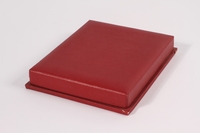
Gold medallion with case awarded to a Macedonian Jewish partisan woman
Object
Gold medallion awarded to Jamila (Zamila) Kolonomos, a partisan fighter during World War II. Jugohrom is the name of a ferroalloy factory that was established in 1952 by the state. The factory was later privatized and is still in operation in Jegunovce, Macedonia, 50 kilometers from Skopje. On April 6, 1941, the Axis powers, Germany, Italy, Hungary, and Bulgaria, invaded and partitioned Yugoslavia. The Macedonian region, including Bitola where Jamila and her family lived, was occupied by Bulgaria. Jamila worked with resistance groups to fight the occupation and was forced to hide at night for her safety. On March 9, 1943, from her hiding place, Jamila witnessed the roundup and deportation of the Jewish community of Bitola. After a month in hiding, she went to the mountains and joined a partisan detachment. In August 1943, Jamila’s group became part of the Macedonian Partisan Battalion, which liberated a prisoner camp in Greece. In June 1944, a separate Macedonian brigade was formed. In August, Jamila was injured during a battle. On October 30, Jamila’s group liberated the towns of Ohrid and Struga, and a month later Macedonia was liberated. In December, Jamila served as an official at the Second Congress of Anti-Fascist Youth in Skopje. Jamila married a fellow partisan Chede Filipovski. Germany surrendered on May 7, 1945. Jamila returned to Bitola and discovered that her entire family had been deported and murdered at Treblinka killing center. In June Chede was killed in a motorcycle accident. In June 1947, Jamila married Avram Sadikario.
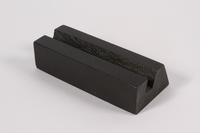
Macedonian-Kosovo Brigade plaque with stand awarded to a Macedonian Jewish partisan woman
Object
Plaque awarded to Jamila (Zamila) Kolonomos commemorating the creation of the Macedonian-Kosovo Brigade which she served in during the Axis occupation of Yugoslavia from 1941-1945. The brigade was created on November 11, 1943, with 800 troops and by the end of the war numbered 66,000 members. On April 6, 1941, the Axis powers, Germany, Italy, Hungary, and Bulgaria, invaded and partitioned Yugoslavia. The Macedonian region, including Bitola where Jamila and her family lived, was occupied by Bulgaria. Jamila worked with resistance groups to fight the occupation and was forced to hide at night for her safety. On March 9, 1943, from her hiding place, Jamila witnessed the roundup and deportation of the Jewish community of Bitola. After a month in hiding, she went to the mountains and joined a partisan detachment. In August 1943, Jamila’s group became part of the Macedonian Partisan Battalion, which liberated a prisoner camp in Greece. In June 1944, a separate Macedonian brigade was formed. In August, Jamila was injured during a battle. On October 30, Jamila’s group liberated the towns of Ohrid and Struga, and a month later Macedonia was liberated. In December, Jamila served as an official at the Second Congress of Anti-Fascist Youth in Skopje. Jamila married a fellow partisan Chede Filipovski. Germany surrendered on May 7, 1945. Jamila returned to Bitola and discovered that her entire family had been deported and murdered at Treblinka killing center. In June Chede was killed in a motorcycle accident. In June 1947, Jamila married Avram Sadikario.
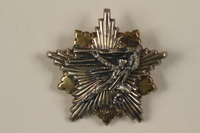
Partizanska spomenica medal awarded to a Macedonian Jewish partisan woman
Object
Partizanska spomenica medal awarded to Jamila (Zamila) Kolonomos for her service as a partisan during the Axis occupation of Yugoslavia from 1941-1945. Of the 27,629 medals awarded, only 12 of them went to Jews who, like Jamila, were from Bitola. The medal was first instituted in 1943, and the design revised to this version in 1945. On April 6, 1941, the Axis powers, Germany, Italy, Hungary, and Bulgaria, invaded and partitioned Yugoslavia. The Macedonian region, including Bitola where Jamila and her family lived, was occupied by Bulgaria. Jamila worked with resistance groups to fight the occupation and was forced to hide at night for her safety. On March 9, 1943, from her hiding place, Jamila witnessed the roundup and deportation of the Jewish community of Bitola. After a month in hiding, she went to the mountains and joined a partisan detachment. In August 1943, Jamila’s group became part of the Macedonian Partisan Battalion, which liberated a prisoner camp in Greece. In June 1944, a separate Macedonian brigade was formed. In August, Jamila was injured during a battle. On October 30, Jamila’s group liberated the towns of Ohrid and Struga, and a month later Macedonia was liberated. In December, Jamila served as an official at the Second Congress of Anti-Fascist Youth in Skopje. Jamila married a fellow partisan Chede Filipovski. Germany surrendered on May 7, 1945. Jamila returned to Bitola and discovered that her entire family had been deported and murdered at Treblinka killing center. In June Chede was killed in a motorcycle accident. In June 1947, Jamila married Avram Sadikario.
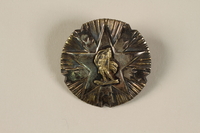
Orden Zasluge Za Narod 2nd class awarded to a Macedonian Jewish partisan woman
Object
Yugoslav Order of Merit to the Nation (People), 2nd class, awarded to Jamila (Zamila) Kolonomos in recognition of her service as a partisan during the Axis occupation of Yugoslavia from 1941-1945. The medal was awarded to those who distinguished themselves in the struggle for liberation and merit in securing and organizing the Yugoslav government and army, and for achievement in the economic, cultural and social spheres. This medal was awarded to 39534 people. On April 6, 1941, the Axis powers, Germany, Italy, Hungary, and Bulgaria, invaded and partitioned Yugoslavia. The Macedonian region, including Bitola where Jamila and her family lived, was occupied by Bulgaria. Jamila worked with resistance groups to fight the occupation and was forced to hide at night for her safety. On March 9, 1943, from her hiding place, Jamila witnessed the roundup and deportation of the Jewish community of Bitola. After a month in hiding, she went to the mountains and joined a partisan detachment. In August 1943, Jamila’s group became part of the Macedonian Partisan Battalion, which liberated a prisoner camp in Greece. In June 1944, a separate Macedonian brigade was formed. In August, Jamila was injured during a battle. On October 30, Jamila’s group liberated the towns of Ohrid and Struga, and a month later Macedonia was liberated. In December, Jamila served as an official at the Second Congress of Anti-Fascist Youth in Skopje. Jamila married a fellow partisan Chede Filipovski. Germany surrendered on May 7, 1945. Jamila returned to Bitola and discovered that her entire family had been deported and murdered at Treblinka killing center. In June Chede was killed in a motorcycle accident. In June 1947, Jamila married Avram Sadikario.
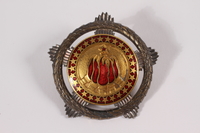
Orden Bratstva I Jedinstva awarded to a Macedonian Jewish partisan woman
Object
Order of Brotherhood and Unity 1st class medal awarded to Jamila (Zamila) Kolonomos in recognition of her service as a partisan during the Axis occupation of Yugoslavia from 1941-1945. The medal was awarded to both citizens and foreigners for creation and promotion of brotherhood and unity when the resistance movement was divided by politics, nationality and other factors. On April 6, 1941, the Axis powers, Germany, Italy, Hungary, and Bulgaria, invaded and partitioned Yugoslavia. The Macedonian region, including Bitola where Jamila and her family lived, was occupied by Bulgaria. Jamila worked with resistance groups to fight the occupation and was forced to hide at night for her safety. On March 9, 1943, from her hiding place, Jamila witnessed the roundup and deportation of the Jewish community of Bitola. After a month in hiding, she went to the mountains and joined a partisan detachment. In August 1943, Jamila’s group became part of the Macedonian Partisan Battalion, which liberated a prisoner camp in Greece. In June 1944, a separate Macedonian brigade was formed. In August, Jamila was injured during a battle. On October 30, Jamila’s group liberated the towns of Ohrid and Struga, and a month later Macedonia was liberated. In December, Jamila served as an official at the Second Congress of Anti-Fascist Youth in Skopje. Jamila married a fellow partisan Chede Filipovski. Germany surrendered on May 7, 1945. Jamila returned to Bitola and discovered that her entire family had been deported and murdered at Treblinka killing center. In June Chede was killed in a motorcycle accident. In June 1947, Jamila married Avram Sadikario.

Ordena Republike Sa Srebrnim Vencem awarded to a Macedonian Jewish partisan woman
Object
Order of the Republic awarded to Jamila (Zamila) Kolonomos a WWII partisan fighter on November 7, 1961, in recognition for civil merits and public activities, achievements in science and art, education and enlightenment, culture and sports. On April 6, 1941, the Axis powers, Germany, Italy, Hungary, and Bulgaria, invaded and partitioned Yugoslavia. The Macedonian region, including Bitola where Jamila and her family lived, was occupied by Bulgaria. Jamila worked with resistance groups to fight the occupation and was forced to hide at night for her safety. On March 9, 1943, from her hiding place, Jamila witnessed the roundup and deportation of the Jewish community of Bitola. After a month in hiding, she went to the mountains and joined a partisan detachment. In August 1943, Jamila’s group became part of the Macedonian Partisan Battalion, which liberated a prisoner camp in Greece. In June 1944, a separate Macedonian brigade was formed. In August, Jamila was injured during a battle. On October 30, Jamila’s group liberated the towns of Ohrid and Struga, and a month later Macedonia was liberated. In December, Jamila served as an official at the Second Congress of Anti-Fascist Youth in Skopje. Jamila married a fellow partisan Chede Filipovski. Germany surrendered on May 7, 1945. Jamila returned to Bitola and discovered that her entire family had been deported and murdered at Treblinka killing center. In June Chede was killed in a motorcycle accident. In June 1947, Jamila married Avram Sadikario.
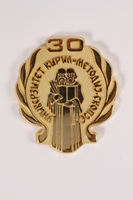
30th anniversary hospital medallion and box awarded to a Macedonian Jewish man
Object
Medallion awarded to Dr. Avram Sadikario in 1979 from the Saints Cyril and Methodius University of Skopje, Yugoslavia (now North Macedannia), where Avram began teaching in 1952. The medallion bears the University’s emblem and was awarded to celebrate the 30th anniversary of its founding. Avram Sadikario was in his third year of studying medicine at the University of Belgrade when the Axis powers declared war on Yugoslavia. On April 4, 1941 he left Belgrade and returned to Bitola. Two days later Germany, Italy, Hungary, and Bulgaria invaded and partitioned Yugoslavia and the Macedonian region was occupied by Bulgaria. Anti-Jewish laws were passed that restricted Avram and his family’s lives. Later that year, Avram joined the Yugoslav Communist Party serving in and founding several underground resistance cells. In 1942 Avram accompanied his brother Sami to Sofia, Bulgaria for medical treatment. While he was gone, his resistance cell was discovered and Avram did not return home with his brother. He remained in Sofia and went into hiding. In spring 1943, Jews were expelled from the city and Avram traveled to a camp in Pleven and was held there until the end of summer. On September 8 1944, he participated in the liberation of the central prison where he remained until he was liberated by the Soviets. Germany surrendered May 7, 1945. After liberation, Avram worked for several months as state security and then as a doctor in Pleven. In June, 1947, Avram married partisan fighter Jamila Kolonomos.
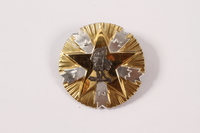
Orden Zasluge Za Narod awarded to a Macedonian Jewish partisan woman
Object
Yugoslav Order of Merit to the Nation (People), 1st class awarded to Jamila (Zmila) Kolonomos in 1975, in recognition of her service as a partisan during the Axis occupation of Yugoslavia from 1941-1945. The medal was awarded to those who distinguished themselves in the struggle for liberation and merit in securing and organizing the Yugoslav government and army, and for achievement in the economic, cultural and social spheres. On April 6, 1941, the Axis powers, Germany, Italy, Hungary, and Bulgaria, invaded and partitioned Yugoslavia. The Macedonian region, including Bitola where Jamila and her family lived, was occupied by Bulgaria. Jamila worked with resistance groups to fight the occupation and was forced to hide at night for her safety. On March 9, 1943, from her hiding place, Jamila witnessed the roundup and deportation of the Jewish community of Bitola. After a month in hiding, she went to the mountains and joined a partisan detachment. In August 1943, Jamila’s group became part of the Macedonian Partisan Battalion, which liberated a prisoner camp in Greece. In June 1944, a separate Macedonian brigade was formed. In August, Jamila was injured during a battle. On October 30, Jamila’s group liberated the towns of Ohrid and Struga, and a month later Macedonia was liberated. In December, Jamila served as an official at the Second Congress of Anti-Fascist Youth in Skopje. Jamila married a fellow partisan Chede Filipovski. Germany surrendered on May 7, 1945. Jamila returned to Bitola and discovered that her entire family had been deported and murdered at Treblinka killing center. In June Chede was killed in a motorcycle accident. In June 1947, Jamila married Avram Sadikario.
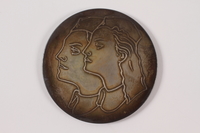
Medallion and box awarded to a Macedonian Jewish partisan woman
Object
Medallion awarded to Jamila (Zamila) Kolonomos by the Women’s Anti-Fascist Front of Macedonia (AFZ). The organization was formed in 1944 with the goal of improving schooling for females and increasing involvement of women in politics and promoting women’s rights. Many of the members of the organization fought as partisans during World War II. On April 6, 1941, the Axis powers, Germany, Italy, Hungary, and Bulgaria, invaded and partitioned Yugoslavia. The Macedonian region, including Bitola where Jamila and her family lived, was occupied by Bulgaria. Jamila worked with resistance groups to fight the occupation and was forced to hide at night for her safety. On March 9, 1943, from her hiding place, Jamila witnessed the roundup and deportation of the Jewish community of Bitola. After a month in hiding, she went to the mountains and joined a partisan detachment. In August 1943, Jamila’s group became part of the Macedonian Partisan Battalion, which liberated a prisoner camp in Greece. In June 1944, a separate Macedonian brigade was formed. In August, Jamila was injured during a battle. On October 30, Jamila’s group liberated the towns of Ohrid and Struga, and a month later Macedonia was liberated. In December, Jamila served as an official at the Second Congress of Anti-Fascist Youth in Skopje. Jamila married a fellow partisan Chede Filipovski. Germany surrendered on May 7, 1945. Jamila returned to Bitola and discovered that her entire family had been deported and murdered at Treblinka killing center. In June Chede was killed in a motorcycle accident. In June 1947, Jamila married Avram Sadikario.
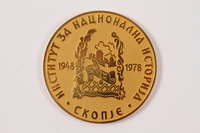
30th Anniversary medallion from the Institute for National History in Skopje
Object
Medallion awarded to Jamila (Zamila) Kolonomos by the Institute for National History in Skopje, Macedonia. The Institute was founded in 1948 and is one of Saints Cyril and Methodius University’s 5 research institutes. It is a public institution that focuses on studying the history of Macedonia and postgraduate and doctoral studies. Jamila was a professor at the University and wrote about the history of Jews in the region. On April 6, 1941, the Axis powers, Germany, Italy, Hungary, and Bulgaria, invaded and partitioned Yugoslavia. The Macedonian region, including Bitola where Jamila and her family lived, was occupied by Bulgaria. Jamila worked with resistance groups to fight the occupation and was forced to hide at night for her safety. On March 9, 1943, from her hiding place, Jamila witnessed the roundup and deportation of the Jewish community of Bitola. After a month in hiding, she went to the mountains and joined a partisan detachment. In August 1943, Jamila’s group became part of the Macedonian Partisan Battalion, which liberated a prisoner camp in Greece. In June 1944, a separate Macedonian brigade was formed. In August, Jamila was injured during a battle. On October 30, Jamila’s group liberated the towns of Ohrid and Struga, and a month later Macedonia was liberated. In December, Jamila served as an official at the Second Congress of Anti-Fascist Youth in Skopje. Jamila married a fellow partisan Chede Filipovski. Germany surrendered on May 7, 1945. Jamila returned to Bitola and discovered that her entire family had been deported and murdered at Treblinka killing center. In June Chede was killed in a motorcycle accident. In June 1947, Jamila married Avram Sadikario.
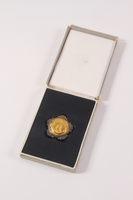
Orden Rada Sa Zlatnim Vencem awarded to a Macedonian Jewish partisan woman
Object
Yugoslav Order of Labor (with the Golden Wreath) 2nd class awarded to Jamila (Zamila) Kolonomos for her contributions to the economy, production and building communism. The medal was awarded to citizens, collectives and military units. On April 6, 1941, the Axis powers, Germany, Italy, Hungary, and Bulgaria, invaded and partitioned Yugoslavia. The Macedonian region, including Bitola where Jamila and her family lived, was occupied by Bulgaria. Jamila worked with resistance groups to fight the occupation and was forced to hide at night for her safety. On March 9, 1943, from her hiding place, Jamila witnessed the roundup and deportation of the Jewish community of Bitola. After a month in hiding, she went to the mountains and joined a partisan detachment. In August 1943, Jamila’s group became part of the Macedonian Partisan Battalion, which liberated a prisoner camp in Greece. In June 1944, a separate Macedonian brigade was formed. In August, Jamila was injured during a battle. On October 30, Jamila’s group liberated the towns of Ohrid and Struga, and a month later Macedonia was liberated. In December, Jamila served as an official at the Second Congress of Anti-Fascist Youth in Skopje. Jamila married a fellow partisan Chede Filipovski. Germany surrendered on May 7, 1945. Jamila returned to Bitola and discovered that her entire family had been deported and murdered at Treblinka killing center. In June Chede was killed in a motorcycle accident. In June 1947, Jamila married Avram Sadikario.
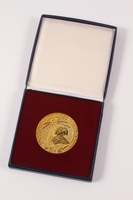
Commemorative medallion awarded to a Macedonian Jewish partisan woman
Object
Medallion awarded to Jamila (Zamila) Kolonomos by the Council for the Care and Education of Children of Macedonia and The Union of the Pioneers of Yugoslavia. The medallion was awarded for Jamila’s work with children’s organizations. On April 6, 1941, the Axis powers, Germany, Italy, Hungary, and Bulgaria, invaded and partitioned Yugoslavia. The Macedonian region, including Bitola where Jamila and her family lived, was occupied by Bulgaria. Jamila worked with resistance groups to fight the occupation and was forced to hide at night for her safety. On March 9, 1943, from her hiding place, Jamila witnessed the roundup and deportation of the Jewish community of Bitola. After a month in hiding, she went to the mountains and joined a partisan detachment. In August 1943, Jamila’s group became part of the Macedonian Partisan Battalion, which liberated a prisoner camp in Greece. In June 1944, a separate Macedonian brigade was formed. In August, Jamila was injured during a battle. On October 30, Jamila’s group liberated the towns of Ohrid and Struga, and a month later Macedonia was liberated. In December, Jamila served as an official at the Second Congress of Anti-Fascist Youth in Skopje. Jamila married a fellow partisan Chede Filipovski. Germany surrendered on May 7, 1945. Jamila returned to Bitola and discovered that her entire family had been deported and murdered at Treblinka killing center. In June Chede was killed in a motorcycle accident. In June 1947, Jamila married Avram Sadikario.
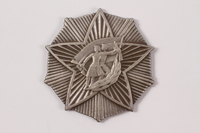
SUBNOR medallion awarded to a Macedonian Jewish partisan woman
Object
Medallion awarded to Jamila (Zamila) Kolonomos by SUBNOR in Yugoslavia, an organization formed in 1961 in Yugoslavia, by merging the Combat Union of War Veterans, the Association of War Officers, and Associations of Reserve Officers and Sub-Officers. The goal of this organization was to preserve the heritage of the war, participation in the reconstruction of the country and aid disabled veterans, and the families of the deceased. On April 6, 1941, the Axis powers, Germany, Italy, Hungary, and Bulgaria, invaded and partitioned Yugoslavia. The Macedonian region, including Bitola where Jamila and her family lived, was occupied by Bulgaria. Jamila worked with resistance groups to fight the occupation and was forced to hide at night for her safety. On March 9, 1943, from her hiding place, Jamila witnessed the roundup and deportation of the Jewish community of Bitola. After a month in hiding, she went to the mountains and joined a partisan detachment. In August 1943, Jamila’s group became part of the Macedonian Partisan Battalion, which liberated a prisoner camp in Greece. In June 1944, a separate Macedonian brigade was formed. In August, Jamila was injured during a battle. On October 30, Jamila’s group liberated the towns of Ohrid and Struga, and a month later Macedonia was liberated. In December, Jamila served as an official at the Second Congress of Anti-Fascist Youth in Skopje. Jamila married a fellow partisan Chede Filipovski. Germany surrendered on May 7, 1945. Jamila returned to Bitola and discovered that her entire family had been deported and murdered at Treblinka killing center. In June Chede was killed in a motorcycle accident. In June 1947, Jamila married Avram Sadikario.

Military medallion, box and paper awarded to a Macedonian Jewish partisan woman
Object
Award received by Jamila (Zamila) Kolonomos in recognition of her service as a partisan during the Axis occupation of Yugoslavia from 1941-1945. On April 6, 1941, the Axis powers, Germany, Italy, Hungary, and Bulgaria, invaded and partitioned Yugoslavia. The Macedonian region, including Bitola where Jamila and her family lived, was occupied by Bulgaria. Jamila worked with resistance groups to fight the occupation and was forced to hide at night for her safety. On March 9, 1943, from her hiding place, Jamila witnessed the roundup and deportation of the Jewish community of Bitola. After a month in hiding, she went to the mountains and joined a partisan detachment. In August 1943, Jamila’s group became part of the Macedonian Partisan Battalion, which liberated a prisoner camp in Greece. In June 1944, a separate Macedonian brigade was formed. In August, Jamila was injured during a battle. On October 30, Jamila’s group liberated the towns of Ohrid and Struga, and a month later Macedonia was liberated. In December, Jamila served as an official at the Second Congress of Anti-Fascist Youth in Skopje. Jamila married a fellow partisan Chede Filipovski. Germany surrendered on May 7, 1945. Jamila returned to Bitola and discovered that her entire family had been deported and murdered at Treblinka killing center. In June Chede was killed in a motorcycle accident. In June 1947, Jamila married Avram Sadikario.
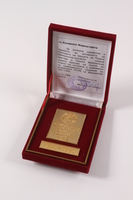
Military service medallion awarded to a Macedonian Jewish partisan woman
Object
Medallion awarded to Jamila (Zamila) Kolonomos on November 11, 1998, in recognition of her service as a partisan during the Axis occupation of Yugoslavia from 1941-1945. On April 6, 1941, the Axis powers, Germany, Italy, Hungary, and Bulgaria, invaded and partitioned Yugoslavia. The Macedonian region, including Bitola where Jamila and her family lived, was occupied by Bulgaria. Jamila worked with resistance groups to fight the occupation and was forced to hide at night for her safety. On March 9, 1943, from her hiding place, Jamila witnessed the roundup and deportation of the Jewish community of Bitola. After a month in hiding, she went to the mountains and joined a partisan detachment. In August 1943, Jamila’s group became part of the Macedonian Partisan Battalion, which liberated a prisoner camp in Greece. In June 1944, a separate Macedonian brigade was formed. In August, Jamila was injured during a battle. On October 30, Jamila’s group liberated the towns of Ohrid and Struga, and a month later Macedonia was liberated. In December, Jamila served as an official at the Second Congress of Anti-Fascist Youth in Skopje. Jamila married a fellow partisan Chede Filipovski. Germany surrendered on May 7, 1945. Jamila returned to Bitola and discovered that her entire family had been deported and murdered at Treblinka killing center. In June Chede was killed in a motorcycle accident. In June 1947, Jamila married Avram Sadikario.
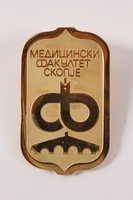
Medallion, box and card from Cyril and Methodius University of Medicine awarded to a Macedonian Jewish man
Object
Medallion awarded to Dr. Avram Sadikario in 1987 by Saints Cyril and Methodius University of Skopje Yugoslavia (now North Macedonia), where Avram began teaching in 1952. The image on the award and certificate is the emblem of Cyril and Methodius University Faculty of Medicine. Avram Sadikario was in his third year of studying medicine at the University of Belgrade when the Axis powers declared war on Yugoslavia. On April 4, 1941 he left Belgrade and returned to Bitola. Two days later Germany, Italy, Hungary, and Bulgaria invaded and partitioned Yugoslavia and the Macedonian region was occupied by Bulgaria. Anti-Jewish laws were passed that restricted Avram and his family’s lives. Later that year, Avram joined the Yugoslav Communist Party serving in and founding several underground resistance cells. In 1942 Avram accompanied his brother Sami to Sofia, Bulgaria for medical treatment. While he was gone, his resistance cell was discovered and Avram did not return home with his brother. He remained in Sofia and went into hiding. In spring 1943, Jews were expelled from the city and Avram traveled to a camp in Pleven and was held there until the end of summer. On September 8 1944, he participated in the liberation of the central prison where he remained until he was liberated by the Soviets. Germany surrendered May 7, 1945. After liberation, Avram worked for several months as state security and then as a doctor in Pleven. In June, 1947, Avram married partisan fighter Jamila Kolonomos.
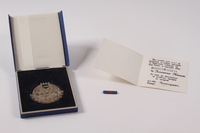
Medallion, box, pamphlet, and bar pin awarded to a Macedonian Jewish partisan woman
Object
Medallion awarded to Jamila (Zamila) Kolonomos in 1965, in recognition of her service as a partisan during the Axis occupation of Yugoslavia from 1941-1945 and to commemorate the anniversary of the end of World War II. On April 6, 1941, the Axis powers, Germany, Italy, Hungary, and Bulgaria, invaded and partitioned Yugoslavia. The Macedonian region, including Bitola where Jamila and her family lived, was occupied by Bulgaria. Jamila worked with resistance groups to fight the occupation and was forced to hide at night for her safety. On March 9, 1943, from her hiding place, Jamila witnessed the roundup and deportation of the Jewish community of Bitola. After a month in hiding, she went to the mountains and joined a partisan detachment. In August 1943, Jamila’s group became part of the Macedonian Partisan Battalion, which liberated a prisoner camp in Greece. In June 1944, a separate Macedonian brigade was formed. In August, Jamila was injured during a battle. On October 30, Jamila’s group liberated the towns of Ohrid and Struga, and a month later Macedonia was liberated. In December, Jamila served as an official at the Second Congress of Anti-Fascist Youth in Skopje. Jamila married a fellow partisan Chede Filipovski. Germany surrendered on May 7, 1945. Jamila returned to Bitola and discovered that her entire family had been deported and murdered at Treblinka killing center. In June Chede was killed in a motorcycle accident. In June 1947, Jamila married Avram Sadikario.
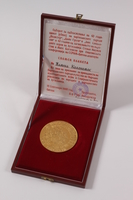
Commemorative medallion with box awarded to a Macedonian Jewish partisan woman
Object
Medallion awarded to Jamila (Zamilla) Kolonomos in 1982 in recognition of her service as a partisan during the Axis occupation of Yugoslavia from 1941-1945. The three partisan groups mentioned on the case, the Jane Sandinski, the Pelister, and Dame Gruev were all formed around the Bitola region in Macedonia in 1942. Jamila served with Damjan Gruev partisan group. On April 6, 1941, the Axis powers, Germany, Italy, Hungary, and Bulgaria, invaded and partitioned Yugoslavia. The Macedonian region, including Bitola where Jamila and her family lived, was occupied by Bulgaria. Jamila worked with resistance groups to fight the occupation and was forced to hide at night for her safety. On March 9, 1943, from her hiding place, Jamila witnessed the roundup and deportation of the Jewish community of Bitola. After a month in hiding, she went to the mountains and joined a partisan detachment. In August 1943, Jamila’s group became part of the Macedonian Partisan Battalion, which liberated a prisoner camp in Greece. In June 1944, a separate Macedonian brigade was formed. In August, Jamila was injured during a battle. On October 30, Jamila’s group liberated the towns of Ohrid and Struga, and a month later Macedonia was liberated. In December, Jamila served as an official at the Second Congress of Anti-Fascist Youth in Skopje. Jamila married a fellow partisan Chede Filipovski. Germany surrendered on May 7, 1945. Jamila returned to Bitola and discovered that her entire family had been deported and murdered at Treblinka killing center. In June Chede was killed in a motorcycle accident. In June 1947, Jamila married Avram Sadikario.
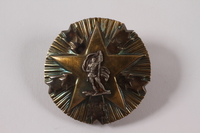
Orden Zasluge Za Narod awarded to a Macedonian Jewish partisan woman
Object
Yugoslav Order of Merit to the Nation (People), 3rd class, awarded to Jamila (Zamila) Kolonomos in recognition of her service as a partisan during the Axis occupation of Yugoslavia from 1941-1945. The medal was awarded to those who distinguished themselves in the struggle for liberation and merit in securing and organizing the Yugoslav government and army, and for achievement in the economic, cultural and social spheres. On April 6, 1941, the Axis powers, Germany, Italy, Hungary, and Bulgaria, invaded and partitioned Yugoslavia. The Macedonian region, including Bitola where Jamila and her family lived, was occupied by Bulgaria. Jamila worked with resistance groups to fight the occupation and was forced to hide at night for her safety. On March 9, 1943, from her hiding place, Jamila witnessed the roundup and deportation of the Jewish community of Bitola. After a month in hiding, she went to the mountains and joined a partisan detachment. In August 1943, Jamila’s group became part of the Macedonian Partisan Battalion, which liberated a prisoner camp in Greece. In June 1944, a separate Macedonian brigade was formed. In August, Jamila was injured during a battle. On October 30, Jamila’s group liberated the towns of Ohrid and Struga, and a month later Macedonia was liberated. In December, Jamila served as an official at the Second Congress of Anti-Fascist Youth in Skopje. Jamila married a fellow partisan Chede Filipovski. Germany surrendered on May 7, 1945. Jamila returned to Bitola and discovered that her entire family had been deported and murdered at Treblinka killing center. In June Chede was killed in a motorcycle accident. In June 1947, Jamila married Avram Sadikario.
Jamila Kolonomos collection
Document
Consists of a collection of 67 pre-war, wartime, and post-war photographs of Macedonian survivors, resistance fighters, and rescuers. The photographs were used in "Monastir without Jews: Recollections of a Jewish partisan in Macedonia" by Jamila Kolonomos. Contains photographs of Ms. Kolonomos, her family, and members of the partisan group known as the Macedonian Brigade. Also contains one CD of the images.
Oral testimony of Avram Sadikario
Oral History
Jamila Kolonomos papers
Document
Contains a postcard from Haim Koen sent during the deportation from Bitola, Macedonia on March 11, 1943, to his relative Avram Sadikarios in Sofia, Bulgaria. Mr. Koen writes that he was taken from his home to the train station and he doesn’t know where he will be taken; he asks Avram and Moise to take care of his daughter Sola Koen and not to spare expenses. Also includes a photograph showing Sola Koen in Israel after the war.
Avram Sadikario collection
Document
Collection of photographs and documents relating to the scientific career of Avram Sadikario and Jamila Kolonomos as well as commemorations of the deportation from Bitola, Macedonia. Includes three postcards mailed from Bitola and Skopje in February and March 1943 to Avram Sadikario (donor's late husband) in Sofia, by his brother Sami (later murdered by the Ustasha) and a relative named Mayer Aruesti.



